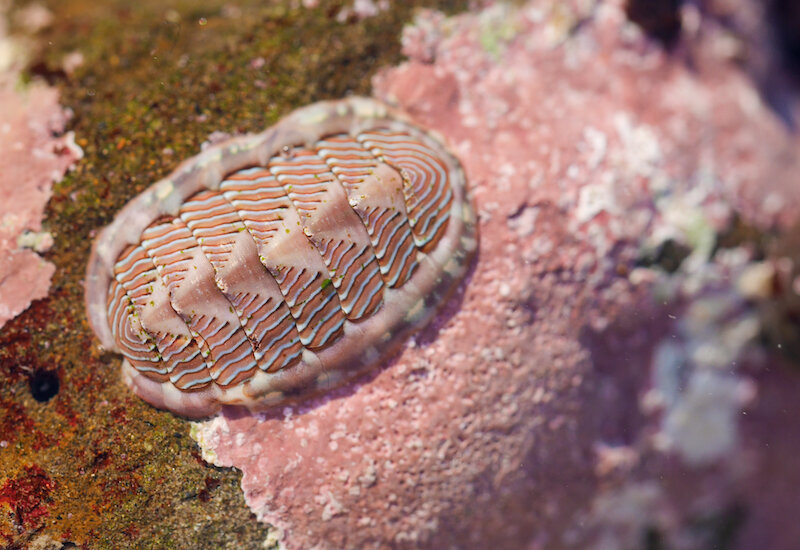One of the largest family of animals is the mollusc family.
The word ‘mollusc’ (sometimes spelled mollusk) means soft-bodied.
Most of them have a hard outside shell to protect their soft body.
Some, like the octopus, do not.
Molluscs have been on Earth for millions of years.
Molluscs are among the earliest forms of life on Earth. There are over 100,000 species of mollusc, and they date back millions of years . In fact, one kind of mollusc, the nautilus, is considered to be a living fossil, unchanged for over 400 million years.
Nautilus
Only a few species (kinds) of nautilus remain, and live at ocean depths of about 550 metres during the day, and shallower water at night.
Nautilus: a living fossil. Photo©iStock
Inside the shell there are many sections called chambers, arranged in a perfect spiral. The animal lives only in the largest chamber, which opens to the outside but has a door that it can close when it pulls itself inside. By controlling the balance of gas and water in the chambers, the nautilus stays floating and is able to dive or ascend, to move forward or back.
The nautilus has about 90 small tentacles with which it catches its prey, mostly small crabs and other crustaceans. Unlike its relatives the octopus, squid and cuttlefish, its eyesight is poor. Like them it has three hearts and blue blood: two hearts pump blood to its gills and one pumps oxygenated blood through the body.
Inside a nautilus shell cut in half it is a perfect spiral. ©Getty
Where do molluscs live?
Snails are molluscs. Many are land dwelling. ©Getty
Some molluscs live along rocky shores, in freshwater habitats and even in gardens.
Some molluscs are land living, such as the snail and slug.
Other molluscs live in salt water, such as water snails, sea slugs, octopus and squid, bivalves such as oysters, mussels and clams, chitons (say kigh-tun) and tusk shells.
Body and Behaviours
Molluscs have a soft body and are invertebrates, which means they have no backbone. Most have a shell, either outside or inside, and a radula (say rad-you-luh) that is like a tongue but with many tiny teeth.
A blue-lined octopus. Photo©Getty
Some molluscs, such as octopus and squid, have tentacles. They are in the group of molluscs called cephalopods (say ceff-luh-pods or keff-luh-pods)
Some have a foot, which is a muscle inside the body that ripples along and helps the animal move by sliding along.
Most ocean living molluscs can move by jet propulsion, squirting water from their body to move forward. Those with shells, such as clams and scallops, can move by clamping their shell closed and ejecting water, which shoots them along.
However, some ocean living molluscs attach themselves to rocks or other surfaces and don't move.
Clams are bivalves. Photo©iStock
Bivalves
Bivalve means ‘two valves’. The soft-bodied animal lives inside a double shell, or valve, with a hinge that opens and closes the valves. When the animal dies, the hinge usually breaks, and the empty shells wash up on the beach. Most bivalves are marine, or saltwater, creatures. They feed by passing water through their gills, filtering out the tiny plankton for food as the water passes through. Bivalves don’t move around much. Some attach themselves to hard places, some attach onto rocks, some burrow in the sand.
Sea slugs
The sea slug is sometimes known as the sea cucumber because of its shape and because it is usually very still, looking like a plant. Because of this habit of not moving very much, sea slugs are a common prey for many animals, such as crabs, lobsters, fish and humans.
One kind of sea slug.. there are thousands of different kinds. Photo©iStock
There are thousands of different kinds of sea slug, ranging in size from a few millimetres to over 30 centimetres long. They are a variety of colours. Some are dramatically coloured.
Sea slugs feed on algae, plankton and decomposing matter on the sea bed. This cleaning up makes them a useful part of the marine ecosystem.
A brightly coloured sea slug. ©Getty
An ecosystem means that all the living things in an area interact with each other and with non-living things such as weather, soil, climate.
Each has its part to play to keep their ecosystem balanced and healthy.
This sea slug is called blue and white lettuce. ©Getty
Chitons
Chitons are hard to find as they are well camouflaged and generally hide in cracks in the rocks or under boulders, hiding from light. They are covered with eight overlapping plates that protect them from predators and from crashing waves.
Chiton. Photo©iStock
When disturbed, they clamp their muscular foot on the rocks and are very hard to move.
Chitons feed by using their radula to scrape algae off rocks. Their eyes are inside the shell.
There are about 150 different kinds of chitons in Australia, and about 90% of them are endemic (found nowhere else).
A lined chiton found in the North Pacific Ocean. ©Getty
Threats
Threats to the survival of marine molluscs include ocean pollution and the warmer water temperatures caused by global warming which alters their habitat.
The habitat of shore dwelling or land dwelling molluscs is altered by human activity or destroyed by introduced species. Most are threatened by over-collecting.
It’s a good idea to get information from more than one source!
Read kidcyber pages about another group of the mollusc family
Cephalopods (octopuses, squids, cuttlefish)
Read more about molluscs (mollusks)
http://www.sciencewithme.com/learn-about-mollusks/
Download fact sheets about different molluscs here
https://australian.museum/learn/animals/molluscs
Watch a video about sea slugs:
http://thekidshouldseethis.com/post/this-jorunna-sea-slug-looks-like-a-tiny-fluffy-sea-bunny












